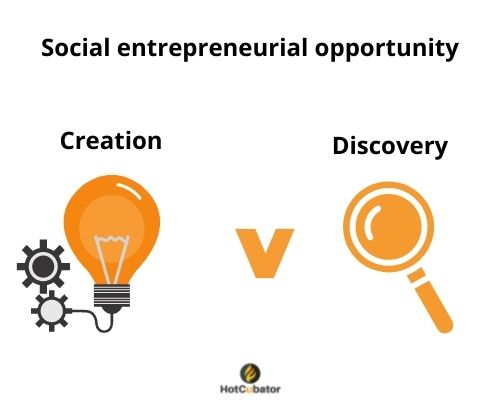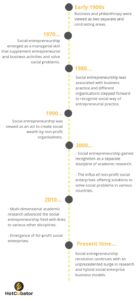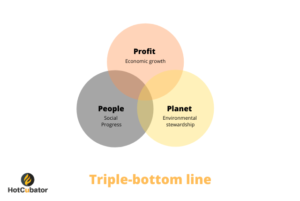
If you are a researcher in the area of social entrepreneurship, there is an interesting topic that you will come across often in the social entrepreneurship literature – whether opportunities are created or discovered. Its important to understand that social entrepreneurship identification of an opportunity is very crucial part in social entrepreneurship. The main purpose of social entrepreneurial opportunity identification is to look for problems that can affect social welfare. The social entrepreneurial opportunities establish a motive to solve social problems through innovative solutions similar to the way commercial entrepreneurs create new and innovative products that enrich, advance, and promote an improved society (Carraher et al., 2016; González et al., 2017).
Let us first unpack the discovery perspective. The discovery theory deals primarily with two major aspects which are – the nature of opportunities and the nature of entrepreneurs (Alvarez & Barney 2007). Therefore, information asymmetries play a decisive role in the discovery perspective, since entrepreneurs are believed to process and re-combine new and old information (Kirzner, 1997). Entrepreneurs are more alert than non-entrepreneurs and thus, able to discover opportunities. This idea belongs to the cognitive component of the discovery school. Hence, systematic differences, such as informational or cognitive factors, explain why entrepreneurs discover opportunities and non-entrepreneurs do not (Alvarez & Barney, 2007). A number of researchers following the discovery perspective have investigated how and why entrepreneurial opportunities occur, often with a focus on economic variables, thereby, establishing the basis for the opportunity discovery school (Alvarez & Barney, 2007; Suddaby et al., 2015).
Schumpeterian opportunities can be seen from three disequilibrium states. These are technological advancement, political and regulatory influence and social and demographic change (Schumpeter, 1934). Drucker (1985) differentiates between three different categories of opportunities arising from economic disequilibria which are – new information, market inefficiencies, and changes in relative costs and benefits of resource exploitation. Sources of information and networks can play a decisive role for the recognition of opportunities. Shane and Nicollaou (2015) identified two categories that have an impact on the propensity to discover an opportunity which include prior information and cognitive properties. Shane (2012) was very explicit, saying that opportunities are objective realities that exist in the environment and are discovered as a result of the unique characteristics of individual entrepreneurs (Shane, 2012). Therefore, it can be summarised that the discovery theory resides on the understanding that entrepreneurial opportunities are objective phenomena reliant on exogenous information and idiosyncrasies of the entrepreneur to understand and exploit them to create something entirely new. The following table summarises the discovery theory and the relevant properties –
| Entrepreneurial opportunity | Underlying considerations | Contributors |
| Discovery theory | Information search related to pre-existing solution, cognitive properties entrepreneurial alertness, perception of the environment, | (Kirzner, 1979); (Sarasvathy et al., 2003); (Alvarez & Barney, 2007) ; (Eckhardt & Shane, 2003); (Shane & Nicolaou, 2015); (Gartner et al., 2017)
|
Table – Underlying considerations of Discovery Theory
The creation perspective
Contrary to the discovery perspective, several authors have looked at opportunity recognition as a creative process (Alvarez & Barney, 2007; Sarasvathy, 2001; Sarasvathy et al., 2003). According Alvarez and Barney (2007)– “entrepreneurs do not recognise opportunities first and then act; rather, they act, wait for a response from their actions – usually from the market – and then they readjust and act again” (2007, p. 7). This view argues that entrepreneurial opportunities are ultimately determined, not in an exogenous fashion by the external environment, but rather in an endogenous way, through the creative imagination and social skill of the entrepreneur (Gaglio & Winter, 2017; Sarasvathy, 2001; Suddaby et al., 2015). Factors that contribute to the entrepreneurial opportunity as per the creation logic are technological advances, political or regulatory climate and demographic shifts (Gartner et al., 2017). Responding to the opportunity is at the core of creativity theory but entrepreneurs rarely see “the end from the beginning” (Alvarez & Barney, 2007, p. 7). Key to this belief is that opportunities do not pre-exist and that the entrepreneur actively creates the external circumstances and the opportunity. Suddaby et al. postulated a more nuanced view and suggested –
Entrepreneurship opportunity, from this point of view, extends beyond identifying and filling gaps in the market. Entrepreneurship opportunity exists in a broader social or cultural context and is articulated through the interaction of an entrepreneur’s unique and creative perceptions and the demands of the marketplace (2015, p. 3).
In creation logic, entrepreneurial opportunity is not considered an objective phenomenon that occurs within the environment prior to the agency of the entrepreneur, rather opportunities are considered endogenous and iterative acts of creation in which the entrepreneur socially constructs the opportunities leading to the product or service (Suddaby et al., 2015). The decision-making process, in this logic, is considered as incremental where focus is given on flexible learning (Alvarez & Barney, 2007). The fundamental distinction between entrepreneurs and non-entrepreneurs are not pre-existent, rather they emerge during the process of creation (Sarasvathy, 2001). Entrepreneurs, as compared with non-entrepreneurs, start by looking at their given and available set of means, this implicitly includes their affordable loss, and then in a step-by-step approach come closer to an opportunity. Instead of choosing between different alternatives, the alternatives are generated (Sarasvathy et al., 2003). This process of action and reaction is considered ‘blind variation’ i.e. “an action that emerges without any self-conscious planning or foresight” (Alvarez & Barney, 2007p. 132). Therefore, the decision-making process is emergent and incremental in nature to remain flexible and able to incorporate learning (Alvarez & Barney, 2007). The following Table summarises the key considerations of the creation theory and the scholars who contributed to this theory of entrepreneurial opportunity.
| Entrepreneurial opportunity | Underlying considerations | Authors |
| Creation theory | Bricolage capacity, enactment to opportunity, innovation radicalness, bricolage capacity, blind or myopic variations | (Garud & Karnøe, 2003) ; (Lvi-Strauss, 1966) ; (Sarasvathy, 2001); (Baker & Nelson, 2005); (Di Domenico et al., 2010) |
Table– Underlying considerations of Creation Theory
Although it is still debated whether opportunities are discovered or created, there is broad agreement that the various contextual factors play a big part in determining which approach is applicable to social entrepreneurial opportunity identification (Perry et al., 2012).
How to reference this article –
Hossain, S. (10 May, 2019) Are opportunities discovered or created in social entrepreneurship? Source – https://hotcubator.com.au/uncategorised/are-opportunitie…entrepreneurship/
References:
Alvarez, S. A., & Barney, J. B. (2007). Discovery and creation: Alternative theories of entrepreneurial action. Strategic entrepreneurship journal, 1(1‐2), 11-26.
Baker, T., & Nelson, R. E. (2005). Creating something from nothing: Resource construction through entrepreneurial bricolage. Administrative Science Quarterly, 50(3), 329-366.
Carraher, S. M., Welsh, D. H., & Svilokos, A. (2016). Validation of a measure of social entrepreneurship. European Journal of International Management, 10(4), 386-402.
Di Domenico, M., Haugh, H., & Tracey, P. (2010). Social bricolage: Theorizing social value creation in social enterprises. Entrepreneurship theory and practice, 34(4), 681-703.
Drucker, P. F. (1985). Entrepreneurial strategies. California Management Review, 27(2), 9-25.
Eckhardt, J. T., & Shane, S. A. (2003). Opportunities and entrepreneurship. Journal of Management, 29(3), 333-349.
Gaglio, C. M., & Winter, S. (2017). Entrepreneurial Alertness and Opportunity Identification: Where Are We Now? In Revisiting the Entrepreneurial Mind (pp. 339-358). Springer International Publishing. https://doi.org/10.1007/978-3-319-45544-0_21
Gartner, W. B., Teague, B. T., Baker, T., & Wadhwani, R. D. (2017). A brief history of the idea of opportunity. Research Handbook on Entrepreneurial Opportunities: Reopening the Debate, 3(4), 45-54.
Garud, R., & Karnøe, P. (2003). Bricolage versus breakthrough: distributed and embedded agency in technology entrepreneurship. Research policy, 32(2), 277-300.
González, M. F., Husted, B. W., & Aigner, D. J. (2017). Opportunity discovery and creation in social entrepreneurship: an exploratory study in Mexico. Journal of Business Research, 81(1), 212-220. https://doi.org/http://dx.doi.org/10.1016/j.jbusres.2016.10.032
Holcombe, R. G. (2003). The origins of entrepreneurial opportunities. The Review of Austrian Economics, 16(1), 25-43.
Kirzner, I. M. (1979). Perception, opportunity, and profit: Studies in the theory of entrepreneurship. University of Chicago Press.
Kirzner, I. M. (1997). Entrepreneurial discovery and the competitive market process: An Austrian approach. Journal of economic Literature, 35(1), 60-85.
Lvi-Strauss, C. (1966). The savage mind. University of Chicago Press.
Perry, J. T., Chandler, G. N., & Markova, G. (2012). Entrepreneurial effectuation: a review and suggestions for future research. Entrepreneurship theory and practice, 36(4), 837-861.
Sarasvathy, S. (2001). Causation and effectuation: Toward a theoretical shift from economic inevitability to entrepreneurial contingency. Academy of Management Review, 26(2), 243-263.
Sarasvathy, S., Dew, N., Velamuri, S., & Venkataraman, S. (2003). Three views of entrepreneurial opportunity. In A. D. Acs Z. (Ed.), Handbook of entrepreneurship research, An Interdisciplinary Survey and Introduction (2nd ed., Vol. 5, pp. 141–160). Springer.
Schumpeter. (1934). The theory of economic development: An inquiry into profits, capital, credit, interest, and the business cycle (Vol. 55). Transaction publishers.
Shane, S. (2012). Reflections on the 2010 AMR decade award: delivering on the promise of entrepreneurship as a field of research. Academy of Management Review, 37(1), 10-20.
Shane, S., & Nicolaou, N. (2015). Creative personality, opportunity recognition and the tendency to start businesses: A study of their genetic predispositions. Journal of business venturing, 30(3), 407-419.
Suddaby, R., Bruton, G. D., & Si, S. X. (2015). Entrepreneurship through a qualitative lens: Insights on the construction and/or discovery of entrepreneurial opportunity. Journal of Business Venturing, 30(1), 1-10.








